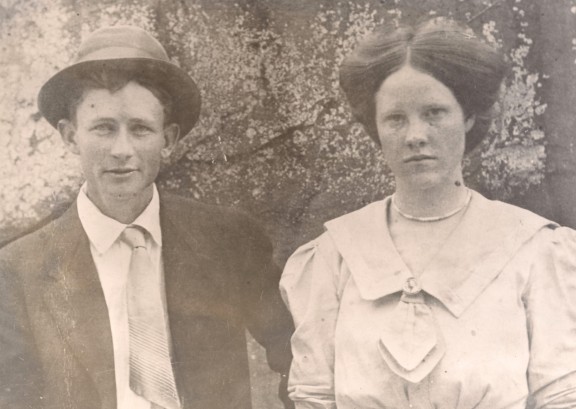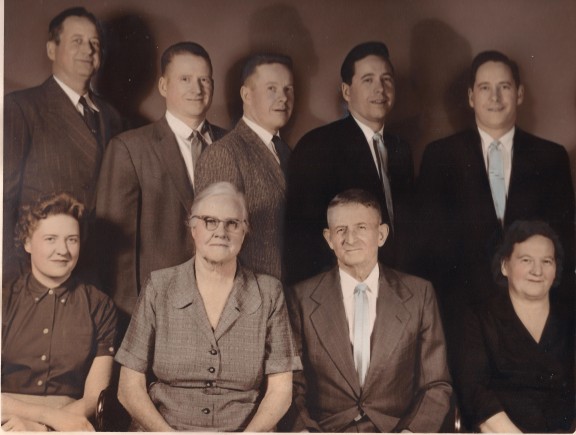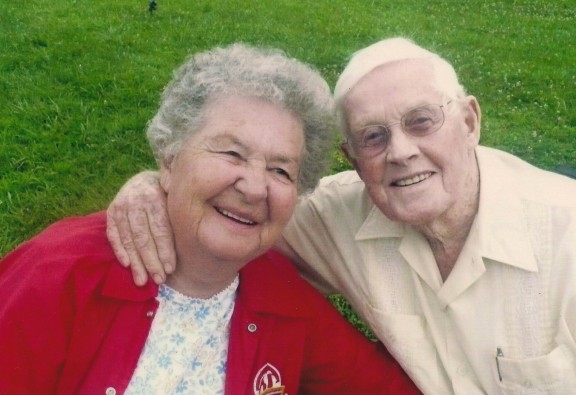Looking back at those days, I remember wondering why it was that Elmo walked with a limp, but I don’t think I ever asked anyone the reason. In fact, I didn’t find out why until just recently. Before telling that part of his story, here is some background information.
Elmo is the son of Joseph (known as Joe) and Eliza Jane (Neal) Gilpatrick. He is third in a family of seven children whose names are: Otto; Cato, Vallie; twin brothers Lee and Lon; and Bonnie. Joe Gilpatrick was a sharecropper while his children were growing up. The family lived on a farm in the Rickman community, and the children attended grade school there. Some years later, Mr. Gilpatrick bought around six acres of property from Will Parrigan near the Fowler Johnson home and the home of Judge L.D. Bohannon just off what was known then as Highway 42 in Livingston.
The year was 1943 when Elmo was drafted into the United States Army. In March of 1944, the unit he was serving in was sent overseas. North Africa was their first stop, and next came the country of Italy. While serving in the military, Elmo was given what was referred to as a "Tommy Gun," and told "if you hear something coming, shoot." He said the first time he pulled the trigger on this gun, it knocked his helmet off his head and he had to go looking for it. That was prior to the date of October 2, 1944. On that particular day, around 5:00 that morning, it was drizzling rain. The battalion Elmo served with was in an area near Poe Valley, Italy where an outdoor theater had been set up for the troops. Elmo had just gotten a new pair of combat boots, and was wishing he still had his old ones. "There’s just nothing as comfortable as an old pair of shoes," he told me. The new ones were very uncomfortable after having walked quite some distance in them for the first time. In the early morning hours that day, an enemy plane known by the troops as "Bed Check Charlie" could be heard approaching in the distance. As the soldiers began to scatter to find a place to hide, sniper fire from nearby German troops rang out. A bullet grazed Elmo on the left side of his head just over his ear. The gun he was using was a Brownie automatic, one that fires 20 rounds of ammunition very rapidly. As the German attack continued, Elmo was shot again, this time in the left hip and another bullet struck him just above the left knee. Not realizing he was seriously wounded, he got up to try and run, and at the same time, let his fellow soldiers who survived know not to mistake him for one of the enemy. Somehow he managed to get to a rock wall where he laid in a nearby ditch while German soldiers came looking for any survivors. Even though the Germans were close enough for Elmo to hear them talking to each other, he went unnoticed. Most of those in the squad were killed during the attack, but those who did survive were captured. At some point after being wounded, Elmo tied his belt around his leg to try and stop the bleeding, and even though part of his left hip was completely destroyed from enemy fire, he didn’t realize he had been shot anywhere but in the leg. Eventually, medics from another platoon came to his rescue. He was taken to a nearby tent that served as a field hospital. Later that same night, Germans bombed the field hospital, but somehow the area Elmo was in didn’t receive as much damage. He has no memory of that bombing. Eventually, he was flown to an army hospital in Florence, Italy where he was put in a body cast he was required to wear for the next seven months. From Florence, he was transferred to Naples, Italy, and on December 11, 1944, was placed on a ship headed back to the United States. The trip by way of ship took two weeks to complete. During his recovery in Italy, he came down with yellow jaundice and as a result, lost a lot of weight. He got down to around 80 pounds before he began to recover. Part of the treatment he received was penicillin injections given every three hours, day and night, over a period of five or six months.
On Christmas Eve, 1944, Elmo arrived in Charleston, South Carolina, still in a body cast. From Charleston, he was transferred to Temple, Texas, where he stayed until July 10, 1945, the date of his discharge. During the 10 months of recovery in the United States, he often used a coat hanger he had straightened out to run down inside the body cast to scratch his leg with. Since there was no such thing as air conditioning in the hospital in Texas, having a body cast on in hot weather was almost unbearable. Scratching with a coat hanger gave very little relief, but at least it helped some.
During the years Elmo served in the military, it was entirely up to the soldiers to arrange their own transportation back home following their discharge. Elmo managed to get a train from Texas to Cookeville, and from there, he hitchhiked, on crutches, back to Livingston.
Even though Elmo was old enough to be drafted into the military and came very close to losing his life while in service, one thing he did not know how to do, even after he was discharged, was how to drive. Once while home on furlough, he asked a friend by the name of Johnny Mansell to accompany him on the bus to Nashville in search of a car. Since Johnny knew how to drive, it was Elmo’s plan that if they did find a car, Johnny could drive it home. They had no luck in Nashville, but after stopping in Lebanon to inquire about the possibility of anyone having a car for sale, they found what Elmo called "a piece of a car." It was a 1937 Ford Elmo agreed to pay $300.00 for. After he got out of service, he eventually learned to drive. It was while he was sitting in his car on the square in Livingston one night, that he got acquainted with the person who soon became his life’s partner. That young lady was someone by the name of Dimple Willis, the daughter of John Willis and wife Artie Mae (Walker) Willis. The young couple traveled to Rossville, Georgia to get married, and a short time later, using $100.00 Dimple had, and $300.00 Elmo had, they bought a piece of property on Hillview Drive from my grandfather, Marvin McCormick. With the help of Walter Robertson, Elmo was able to borrow $1,000.00 from Union Bank to use toward the building of their first home. Elmo tried to borrow the money on his own, but was turned down because he had not established any kind of credit. Mr. Robertson offered to sign a note with him, and with his help, Elmo and Dimple’s first home was started. Eventually, Elmo went back and borrowed another thousand to complete the house. Teston and Darrell were both born in that home. Dr. Myrtle Smith, who made house calls then, delivered both babies. Her fee for home deliveries was $35.00 for each baby. Later, another son, Avery, was added to the family, followed by a daughter, Deltina. After having three boys, Dimple was very happy to finally have the family completed with a little girl.

Joe Gilpatrick and wife Eliza Jane pose for a photograph when they were young.
Eventually, Elmo bought adjoining property to their first home and constructed the nice brick home he and Dimple continue to live in today. In spite of the fact that Elmo was honorably discharged from the army with a 100% disability, he somehow managed to provide for his family on the $200 pension check he drew each month and by working odd jobs from time to time. Some time later, one of the treating doctors reduced his disability from 100% to 70%, a decision Elmo did not know could be appealed. After the children were old enough to start school, Dimple went to work at the shirt factory. They have lived on Hillview Drive for over 63 years now. For 45 of those years, Dimple had to put Elmo’s sock on his left foot and then tie the shoe on that foot because the treatment he received from his injuries left his hip and knee completely frozen. Since then, corrective surgery has helped with that situation.
One piece of advice Elmo has for young married couples just starting out is to go to the bank and borrow $1,000, whether it’s needed or not, pay it back in a timely manner, so that a good credit rating can be established. He feels there’s nothing more important than starting out with good credit.
The old neighborhood on Hillview Drive has changed a lot since the days of picking strawberries for Lewis and Kate Bilbrey. Only two families from those days are still there, Bill Crabtree, Jr. and his wife, Thelma, and of course, Elmo and Dimple. Their son, Teston, has moved into their old home next door. As I drove up the hill to do the interview with Elmo, I tried to remember all those families who lived there when I did. The kids in that neighborhood I can recall from those days were Bill Goodpasture; Jack Carr; Gaye and Carol Reynolds; Don Copeland; Judy Danner; McCoy, Marie, Joyce, Colleen, and Bobby McDonald; Paula, Mary, and Theda Sidwell; Linda and Annette Eldridge; Wilma Brown; Sandy and Freddy Veal; and David and Lewis Paul Webb. I also remember how nice and clean Elmo kept whatever kind of vehicle he and Dimple had during the years I lived on Hillview. Their home and yard have always had that well manicured look, and continue to do so today. Growing garden vegetables has always been something Elmo and Dimple have been involved with every year, and often, Elmo’s picture with items from their garden has appeared in one of the local papers during gardening time. Elmo has also been recording weather information for around forty years now. He has a collection of calendars that contain the temperature for each day, the amount of rainfall, and other weather related data he can look back on from time to time.

The Gilpatrick family. Back row: Otto; Cato; Elmo; Lee; and Lon. Front row: Bonnie, Eliza; Joe; and Vallie.

A recent photograph of Dimple and Elmo Gilpatrick.